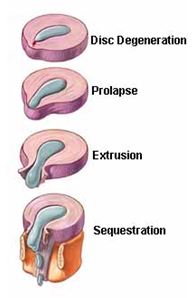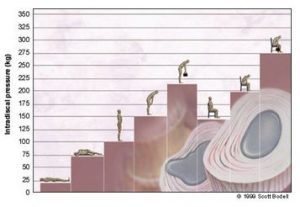Sport Rehabilitation and Physiotherapy for Lumbar Discs

What is a Lumbar Disc?
The intervertebral discs connect the vertebrae of the spine, it has an outer casing of pliable cartilage and a thick gelatinous centre which enables it to provide flexibility, absorption and distribution of load applied to the spinal column.
What happens to Lumbar Discs to cause pain?
With aging, the disc undergoes significant changes in volume and shape as well as in biochemical composition. Lumbar disc problems are believed to result from degeneration that leads to a weakening of the outer casing, leaving the disc susceptible to bulging and tearing.
What is the mechanism of Injury for a Lumbar Disc injury?
Most commonly in those whose work involves prolonged sitting or prolonged / repeated flexed positions (leaning forwards). Excessive lifting and poor posture, particularly in sitting and traumatic injury can also cause this problem. This is because the disc is weakest at its’ rear aspect and bending forward creates a strong rearward pressure pushing the disc toward the spinal nerves.
What are the symptoms of a Lumbar Disc injury?
You may experience pain in the back which may possibly radiate symptoms into the buttocks or legs including pins and needles, pain, numbness, weakness and altered sensation. Mobility will be limited and painful, usually bending forward will be the most painful movement. You may experience an inability to straighten the spine and have an abnormal posture.
What treatments are most commonly used for a Lumbar Disc injury?
Massage – Encompasses a variety of techniques and is given with sufficient pressure through the superficial tissue to reach the deep lying structures. It is used to increase blood flow, reduce muscle spasm and promote normal tissue repair.
Mobilisation – Is a manual technique where the joint and soft tissues are gently moved by the therapist to restore normal range, lubricate joint surfaces and relieve pain.
Manipulation – Is a high speed, short movement thrust given at the end of range. It is used to break down adhesions, remove a blockage within a joint and restore full painless movement. A click or noise may be experienced during this treatment.
Ultrasonic therapy – Transmits sound waves through the tissues stimulating the body’s chemical reactions and therefore healing process, just as shaking a test tube in the laboratory speeds up a chemical reaction.
Interferential therapy – Introduces a small electrical current into the tissues and can be used at varying frequencies for differing treatment effects. E.g. pain relief, muscle or nerve stimulation, promoting blood flow and reducing inflammation.
What other treatments could be used for a Lumbar injury?
Acupuncture – An oriental technique of introducing needles into the skin to increase or decrease energy flow to promote pain relief and healing.
What can you do yourself to help a Lumbar Disc injury?
Exercise programme – This is the most important part of the rehabilitation. Your therapist will instruct you as to which exercises to begin with, when to add the others, as well as how to progress the exercises.
Medication – Ask your GP or Pharmacist for advice on the best medication for your condition.
Heat packs– The application of a hot pack may be beneficial in helping the muscles to relax, promote blood flow to the area and provide pain relief.
Posture – The diagram adjacent clearly indicates the absolute necessity for good posture in maintaining a healthy disc, this enables the muscles of the spine to act as a supporting structure and decreases the strain on the discs.
Ergonomics – Ensure that all your seating is encouraging you to attain good posture and your mattress is supporting your spine adequately.
Lumbar supports – May provide some benefit but should only be used under the guidance of your therapist.

What if physical therapy does not help or resolve a Lumbar Disc problem?
It is very rare that treatment does not give great benefit. In these cases a cortisone or epidural injection may be appropriate and in very extreme cases surgery is a possible option. These options can be discussed with your therapist if appropriate.
If you think you may have this condition we would love the opportunity to show you our expertise in the treatment and management of this condition so – Please click here for details of how to contact us to book an appointment
If you are unsure whether you have this condition or you would just like to speak to somebody then please get in touch here or call 0161 745 7551 or 0151 515 2323.
